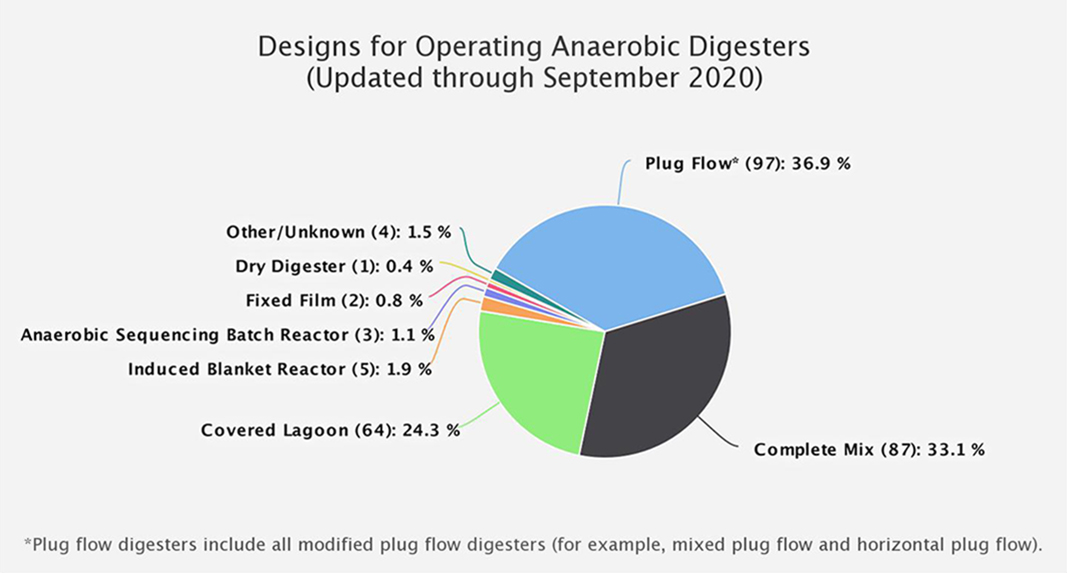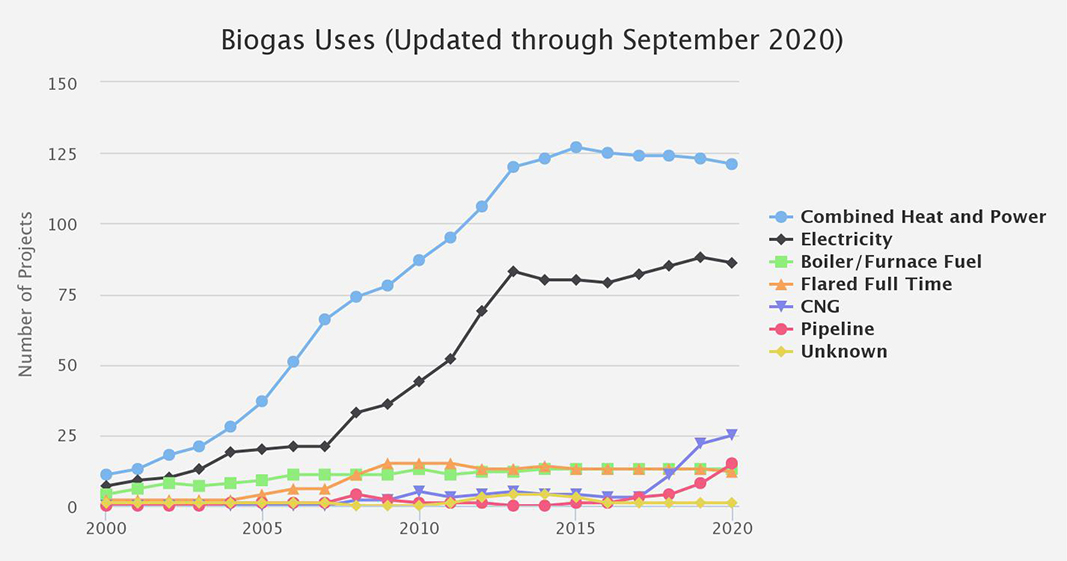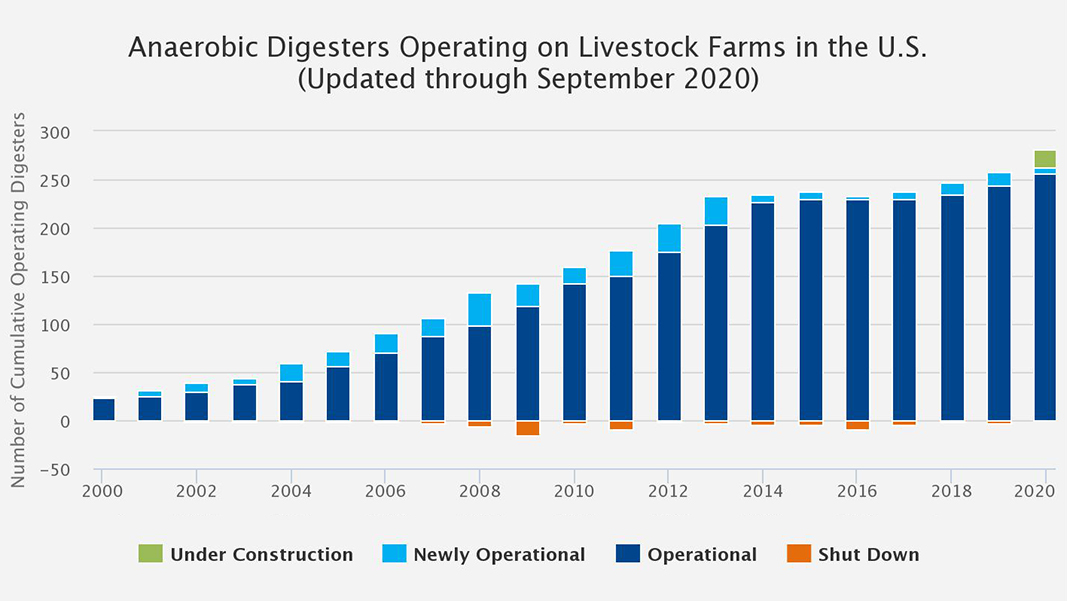Nora Goldstein
The U.S. EPA’s AgSTAR program has been tracking data on farm-based livestock manure anaerobic digestion (AD) for 20 years. AgSTAR typically updates the listings in the database twice a year. Its most recent update found 263 operational projects in the U.S., and 17 in construction (see chart, above). Digesters processing dairy manure lead the pack with 211, followed by digesters that process swine (45), poultry (8), and beef (8) manures. This total exceeds 263 because some projects accept manure from more than one animal type. Of the 263 projects, 107 received U.S. Department of Agriculture grants to help fund digester construction.
The database displays projects in alphabetical order by state. Each listing includes project name, city, digester type, biogas use(s), year started, animal types, codigestion feedstocks (if any), and attributes, e.g., number of animal head, biogas production and electricity generation. Codigestion feedstocks noted include agricultural residues, food processing waste, FOG (fats, oils, grease), process water and food waste.
 “Designs for Operating Anaerobic Digsters” (above) breaks down the number of digesters by AD technology used. Plug flow digesters, which include mixed and horizontal plug flow, are the most common (97 installed, or 36.9%); complete mix is the second most common (87, or 33.1%), followed by covered lagoon (64, or 24.3%). AgSTAR notes that six covered lagoon projects came online in 2020.
“Designs for Operating Anaerobic Digsters” (above) breaks down the number of digesters by AD technology used. Plug flow digesters, which include mixed and horizontal plug flow, are the most common (97 installed, or 36.9%); complete mix is the second most common (87, or 33.1%), followed by covered lagoon (64, or 24.3%). AgSTAR notes that six covered lagoon projects came online in 2020.
A tally by BioCycle found 36 states in the database have farm-based livestock manure anaerobic digesters. Wisconsin has the most (39 operating, 4 in construction), followed by California (38 operating, 1 in construction), Pennsylvania (31 operating), New York (30 operating), North Carolina (20 operating, 4 in construction), and Vermont (15 operating, 1 in construction).
Biogas Use
“Biogas Uses” (below) tracks uses since 2000. The majority of existing farm digesters have CHP engines, generating both electricity and heat; 86 produce electricity only. While the number is still fairly small (15), pipeline injection of renewable natural gas (RNG) is increasing. For example, there were no RNG-to-pipeline projects in 2014, increasing to 3 in 2017 and 4 in 2018. Last year there were 9. Of the 17 digester systems currently under construction, most will produce RNG, notes AgSTAR. In addition, some existing digesters are shifting from electricity generation or combined heat and power (CHP) to RNG production. In 2020, for example, 4 systems in Wisconsin made the shift. Finally, AgSTAR data shows that 25 facilities produce compressed natural gas, primarily for use as vehicle fuel.
 In terms of biogas use trends, AgSTAR notes the following:
In terms of biogas use trends, AgSTAR notes the following:
- CHP projects steadily increased each year from 2000 to 2015, and then began to slightly decline.
- Electricity projects steadily increased each year from 2000 to 2013. Since then, the electricity project count has become more stable.
- Boiler and furnace fuel projects increased much more slowly from 2000 to 2013 and has seen little change since.
- RNG projects, including pipeline injection and compressed natural gas (CNG) for vehicle fuel or other uses, have risen steadily and significantly since 2017 (total of 40 in 2020 vs. 6 in 2017).
- Projects that flare the biogas full time currently make up approximately 4% of all projects.
There was a gradual increase in energy generation from electricity projects and non-electricity projects from 2000 through 2007, and then a more significant increase from 2008 through 2013. In 2020, AD systems on livestock farms are expected to generate the equivalent of approximately 1.41 million megawatt hours (MWh) of electricity, up from 1.35 million MWh in 2019.
Finally, annual emission reductions resulting from U.S. livestock digesters have improved from 4.65 million metric tons of CO2 equivalent (MMTCO2e) in 2019 to 4.81 million MMTCO2e as of September 2020. Reductions in emissions of this size are equivalent to removing 34,000 passenger vehicles from the road for one year.
Editor’s Note — AgSTAR includes the following caveat regarding its database: “Because the data are compiled from a variety of voluntary sources, AgSTAR cannot guarantee the accuracy of the information in the Anaerobic Digester Database. While the Program strives to keep the information as updated and accurate as possible, the database is not exhaustive and may not include data for every anaerobic digester project on livestock farms in the United States.”












